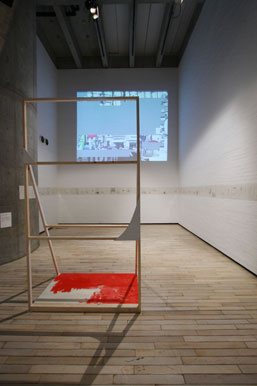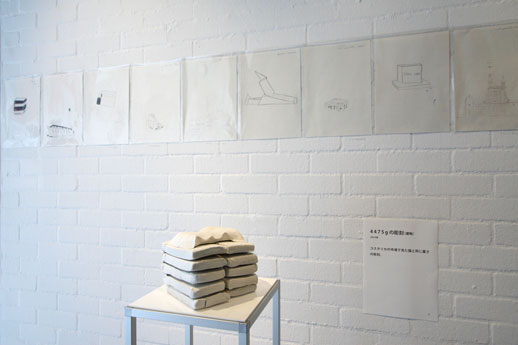Mysteries happily unsolved
In Japanese-born, New York City-based artist Tam Ochiai’s solo exhibit at the Watari, we are invited to view a selection of mixed media pieces informed by the quirky title “spies are only revealed when they get caught.” Ochiai makes use of an unpredictable collection of materials, including acrylic on sheets of plastic, fur, old magazines, canvas, colored pencil on paper, yarn, clay, photography, and video. Serious and playful in equal measure, “spies are only revealed when they get caught” highlights a creative energy in objects and scenarios that may likely otherwise be overlooked.
Having turned on his video camera one day and, discovering that it was broken, Ochiai then presents its ever-changing images beautifully in one of the central pieces titled ‘broken camera’. And, in ‘a photograph who travels’, Ochiai creates a new work out of an image found on an exhibition flyer thirteen years ago. Literally re-presented here and now, Ochiai writes, “It has since traveled a completely unknown road to be exhibited in a totally different place.”
Furthermore, Ochiai displays two quiet moments that resonated with him somehow in the two five-minute videos titled “wave” and “sun.” “wave” is a still and strange clip of the sea in Atlantic City in the middle of the night, illuminated only by the neon lights of casino resorts. Another video, “fake sun,” shows us “something like the sun” documented by 
Ochiai’s sense of humor is further revealed in ‘squirrels in the city’, a series of snapshots taken of strangers walking down the street in New York carrying instruments on their backs. From behind, as Ochiai playfully shows us, these “musicians walk down the street looking like the back of a squirrel.”
The exhibit’s accompanying pamphlet is also delightfully quirky. The pieces are in a way narrated by Ochiai, who has written brief yet puzzling descriptions that seem to ask more questions than provide answers. The exhibit is complicated by this relationship between image and text, between the artist’s words and the physical object in front of you. The descriptions are difficult to de-code, but of course that is what makes it such a pleasure to consider. The one phrase in particular that comes to mind is the description of “a spider web of a Siamese cat, a Siamese cat of a spider web.” I can’t help but smile.
Through this surprising and curious collection of multimedia pieces, we are able to take immediate delight in Ochiai’s visual gifts and also let the quirkiness of it all linger for a long time afterwards. Ochiai’s work invites the viewer to look closer, to consider the dynamics stirring under the surface of the often-understated visual form. As Ochiai concludes, the collection intends to explore the notion of “holding opposite strengths simultaneously,” of art itself as simultaneously “so free yet so impossible to find.” We may never know the answer, but it certainly is an enjoyable thing to wonder about.

“spies are only revealed when they get caught” by Tam Ochiai
May 22 to August 8 at Watari-um
3-7-6 Jingumae, Shibuya-ku, Tokyo 150-0001
Phone: 03-3402-3001
www.watarium.co.jp
Closed on Mondays (Open on July 19)
From 11:00 To 19:00
Wednesdays closing at 21:00
Adults ¥1000, Students ¥800 (multiple entry)
Erika Raberg
Erika Raberg


